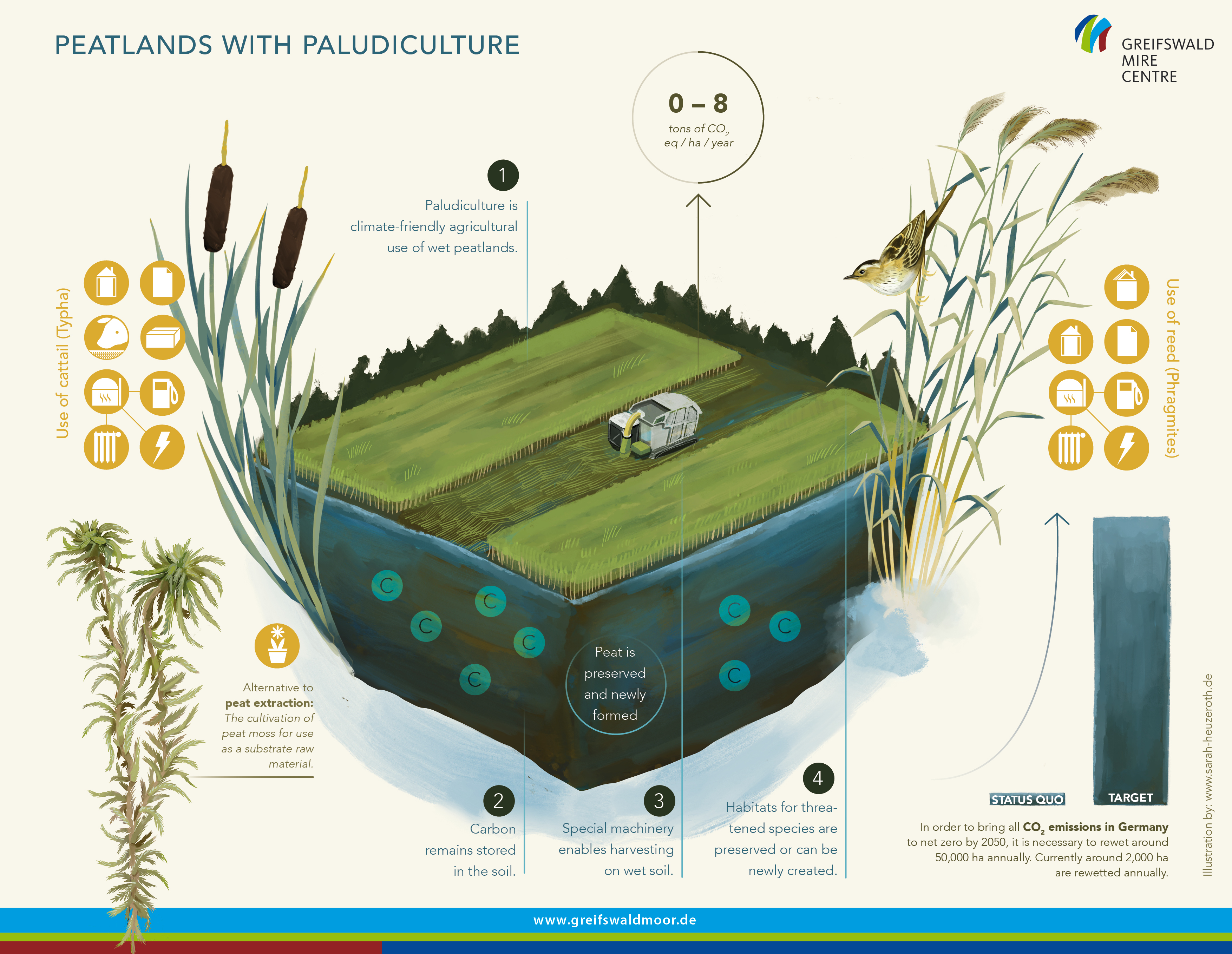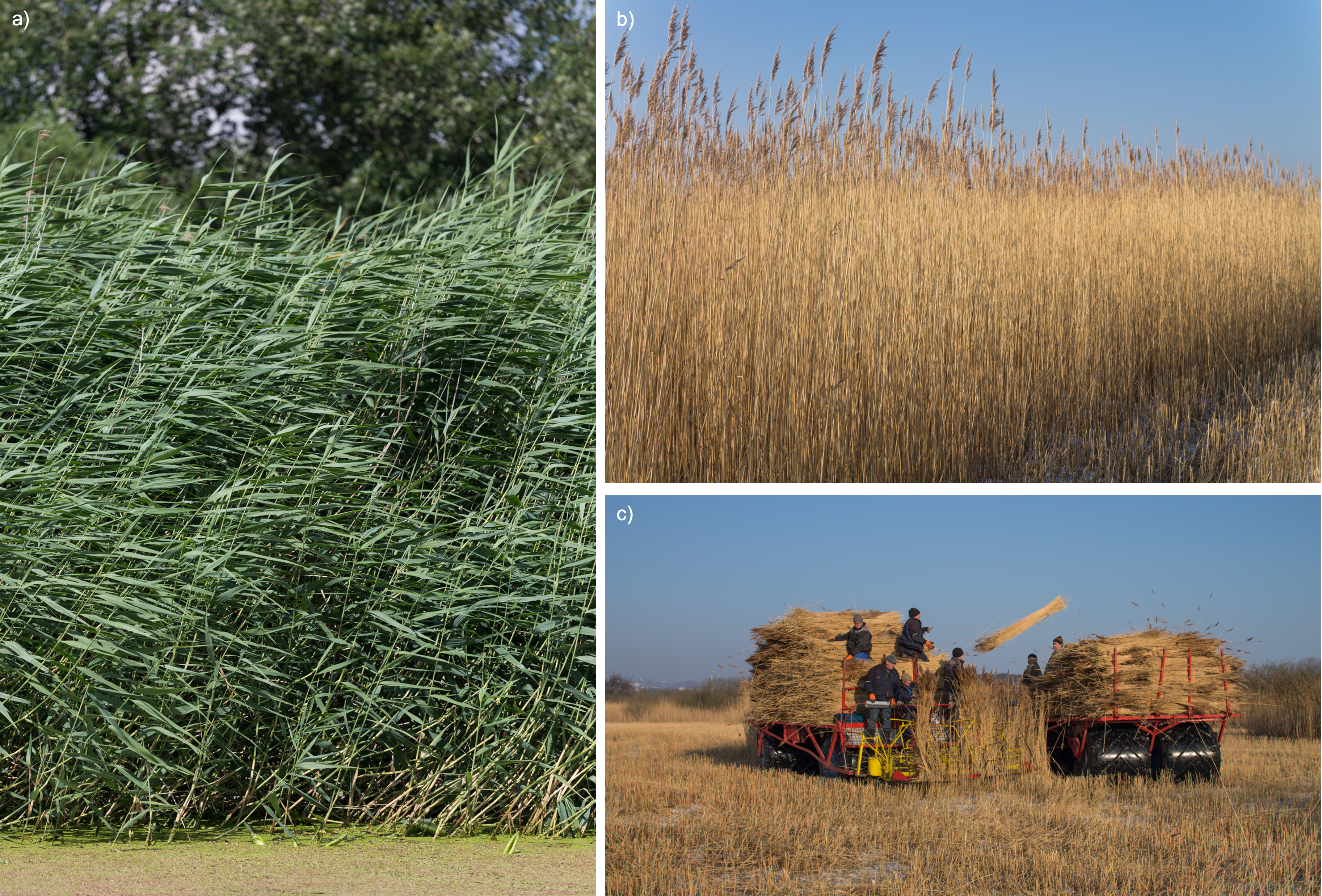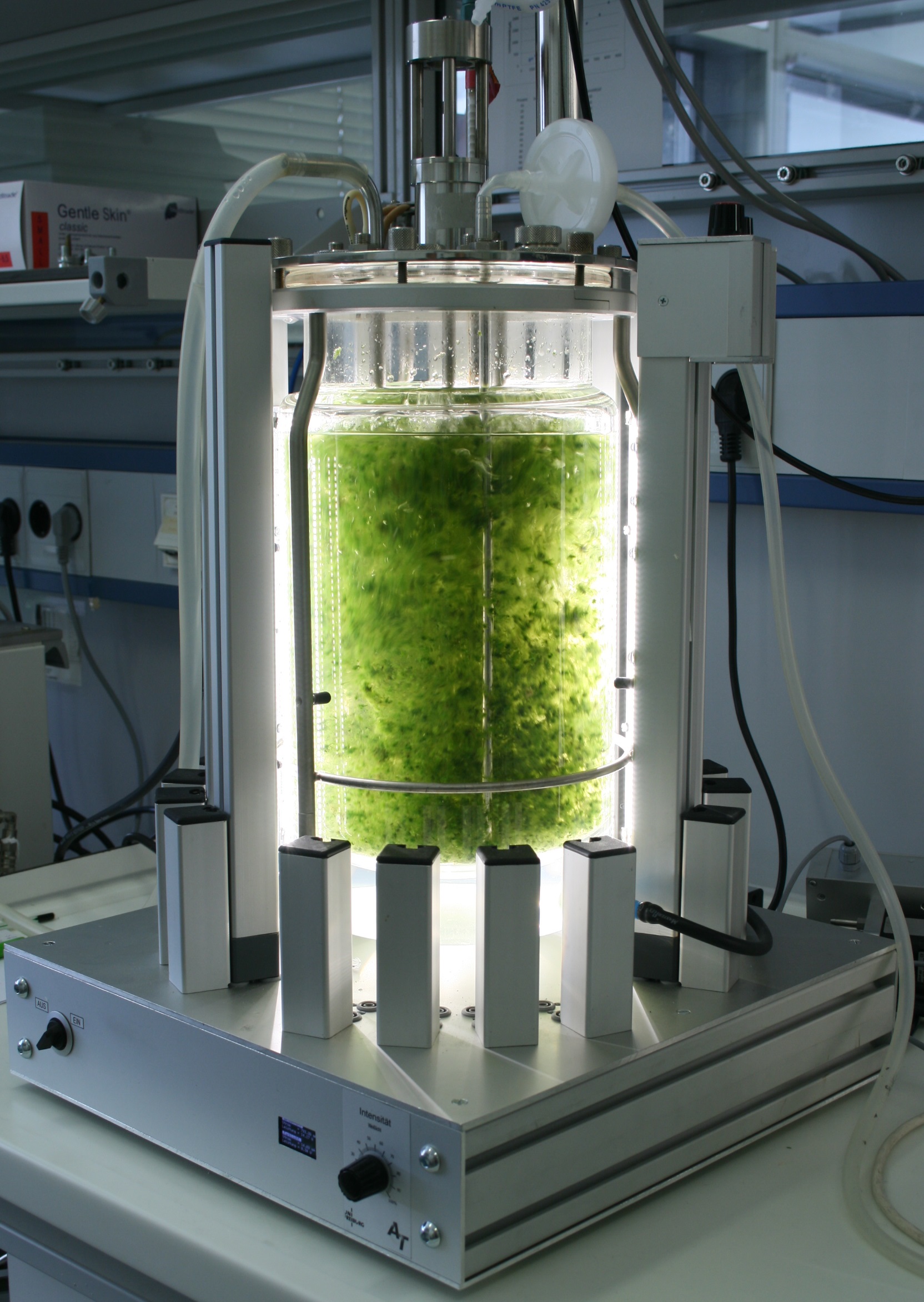Main navigation
Peatlands as CO2 reservoirs: simultaneous renaturation and use
Peatlands store more carbon dioxide than any other ecosystem in the world. However, when drained, they become a climate-damaging source of CO2. The management of wet peatlands reveals exciting solutions, with market potential in the areas of local heating, insulation, packaging and even peat substitution.
Natural peatlands are particularly important reservoirs and sinks for CO2. All peatlands worldwide bind one third of the total soil carbon. However, through drainage - 95 percent of all peatlands in Germany are drained - they become a source of CO2. The reasons for draining peatlands are to reclaim land for agricultural use as well as for commercial forests and building development. In addition, turf is extracted as a substrate for gardening, fruit and vegetable growing.
In a Europe-wide comparison, Germany has the second highest CO2 emissions from peatlands after Norway. The German government has recognised that peatland protection measures make an important contribution to protecting the climate, biodiversity and groundwater. In Mecklenburg-Western Pomerania alone, drained peatlands cause annual climate impact damage costs of over 1 billion euros.1)
Win-win: farming on renaturalised peatlands

Source: Greifswald Mire Centre, Illustration: Sarah Heuzeroth, CC BY-NC-ND, https://creativecommons.org/licenses/by-nc-nd/2.0/de/
The German Federal Ministry for the Environment, Nature Conservation, Nuclear Safety and Consumer Protection (BMUV) has therefore announced the Natural Climate Protection (ANK) action programme, in which the rewetting of peatlands plays a major role.2) According to the German National Peatland Protection Strategy3), agricultural enterprises are to receive financial incentives for putting in place appropriate measures. The expansion of photovoltaic systems on rewetted peatland soils will also be promoted. Dr. Franziska Tanneberger, head of the Greifswald Mire Centre, believes it is particularly important to support farmers and not expect them to act alone: "Subsidies should be redesigned so that climate and environmental protection instruments benefit, and farmers are supported in the transformation."
Conventional agriculture on former peatlands is not productive due to the wet, oxygen-poor environment. And although peatland soils represent only 7 percent of agricultural land in Germany, they are responsible for 37 percent of CO2 emissions from agriculture.1) A disproportionate share, but what can be done? ‘Back to peatlands’ is the best way to describe the core issue. "A considerable CO2 reduction can be achieved in the agricultural sector and at the same time innovative agriculture can be practised," says Tanneberger. The solution is something called paludiculture, the practice of farming on wet land, such as rewetted bogs and fens.
Insulation material, thatched roofs and pulp substitutes
Reed plants form dense stands in wet bogs without special cultivation, and can also be harvested several times a year. After harvesting and drying, the biomass of wet meadows with sedges (sour grasses), for example, can be burnt to generate heat in the local area. As for plants of the genus Typha (ed. note: plants of this genus come with a variety of common names, including reedmade and cattail), they have a very special property: the large cells in their stems make them suitable for use as insulation material. "Now we have companies that specialise in producing natural building materials such as insulation boards and lightweight construction elements," says the scientist from Greifswald University. The advantages: the renewable marsh plant is mould and pressure resistant, highly insulating, takes little energy to produce and is completely recyclable. During production, the thick, light leaves are shortened, sprayed with mineral adhesive and hot-pressed. Depending on the product requirements, the insulation properties and compressive strength can be adjusted.
Reed is also used for thatched roofs. The astonishing thing is that Germany is unable to meet domestic demand for reed, most of which is imported from Poland, Romania and China. "Plants of the genus Typha, which simultaneously fix a lot of carbon and keep it stored as a resource, can serve many markets," says Tanneberger. There are already initial enquiries from companies from many sectors, not just the energy and construction sectors. The plant is resistant to bending and is also interesting as a raw material in the pulp industry for paper production as well as in the packaging industry. Naturally moisture-resistant due to tannins, light and ecological, it can replace plastics in these industries in many cases. An excellent side effect of this is that areas with sour grasses provide habitats for rare animals and plants.
In the Paludi-PRIMA4) project, funded by the German Federal Ministry of Food and Agriculture (BMEL), researchers are searching for suitable plant species and determining optimal crop management on an eight-hectare cultivation area. Under the leadership of Prof. Dr. Dr. Hans Joosten, winner of the 2021 German Environmental Award, recommendations for farms, local authorities and government are also being developed.
The initiative toMOORow of the Michael Otto Environmental Foundation and the Michael Succow Foundation5), launched in 2021, for example, advocates functioning economic incentive systems: the project not only shows how peatlands can be rewetted to reduce CO2 and promote biodiversity, but also how this can be done in an economically feasible way. The aim is to create demand that enables companies to develop effective sustainability strategies within the framework of corporate social responsibility.
Peatlands as the basis for gourmet cuisine
According to Tanneberger, an important step would be to use peat soils for plants that grow naturally in such environments. This includes plants for producing renewable energy, building and packaging materials. Producing food on mineral soils also makes sense. But there are other excellent options that are worth considering.
Water buffaloes are extremely robust animals. They cope well with the moisture and the peat grass and provide meat as well as milk for the production of the much sought-after buffalo mozzarella. Moorland sheep6) also adapt well to damp, barren soils. What’s their secret? This sheep breed is light, hardy and has a bigger than normal rumen volume, so that it can eat large quantities of grass that grows on the nutrient-poor soils. Their meat is considered a delicacy, which makes keeping the breed appealing.
The fibre-rich grass is also easily digestible for horses. Since it grows without pesticides and fertilisers, it is a lucrative business. Likewise, cultivating the herbaceous ground cover plants, buckwheat and blueberries, in wetlands can be appealing, because demand for blueberries in Germany is not met by domestic cultivation.
With more incentives for farms, there is potential for more robust development. There are numerous ideas and research approaches: for example, the start-up ROKO Farming, which has made the renaturation of land possible through gains achieved by vertical farming7). Or approaches such as those taken at the University of Freiburg: the researchers have established the world’s largest laboratory collection of mosses of the genus Sphagnum. This collection can be considered a biotechnological innovation engine.
Peat mosses can be used to measure fine dust, as air purifiers and peat substitute
In the plant biotechnology laboratory at the University of Freiburg, people are shaking things up: different moss cultures grow in containers and vessels. The head of department, Prof. Dr. Ralf Reski, is famous for the moss bioreactor whose special feature is using mosses instead of bacteria, yeasts or animal cells, as organisms to produce human enzymes and immune modulators, among other things. However, genetic engineering experiments are only one area of the Freiburg research group's work. The work with Sphagnum mosses, which is carried out without genetic modification and is geared towards open land use, has a very different objective.
Because mosses were the first plants to settle on bare rock 450 million years ago, they had to obtain nutrients from the air. With their cell walls and waxy outer layer, they also bind heavy metals very well. Reski's team takes advantage of this and attaches dried and ‘clean’ peat mosses grown in the laboratory to trees alongside roads, for example. After a few weeks, the accumulated pollutants are analysed. A clever solution made all the more significant because all EU member states are obliged to monitor air quality and until now had used expensive, electricity-consuming equipment for this purpose.
Peat is still being extracted in Germany and, due to stricter regulations, additionally imported from the Baltic States. Both contribute to the destruction of peatlands. "Almost all vegetable and ornamental plants grow in peat soil; directly or indirectly we all consume peat," explains Dr. Melanie Heck from Reski's team. The problem: at 1 mm per year, moss plants do not form spreadable seeds and grow too slowly in the open. The scientist from Freiburg achieved a milestone in the BMEL-funded MOOSzucht project8): she was able to obtain germ-free seeds in the laboratory from peat mosses that grow 50 to 100 times faster in the bioreactor than in a bog. The cultures are being tested on a demo area in the Hankhauser Moor peatland area in Lower Saxony. Although there are good peat substitutes for amateur gardeners, peat has no alternative when it comes to growing fruit and vegetables. This is due to the high water storage capacity of peat and the presence of many pores which enable roots to spread easily. "The aim is to achieve high yields in the open with the pure cultures and thus make the cultivation of peat moss economical," explains Heck.
There is clear potential for the management of wet peatlands. Rewetting and paludiculture can be implemented if funding instruments are realigned and investment and innovations are reinforced.
References:
1) Hirschelmann et al. (2020): Fact collection - "Moore in Mecklenburg-Vorpommern im Kontext nationaler und internationaler Klimaschutzziele – Zustand und Entwicklungspotenzial". https://greifswaldmoor.de/files/dokumente/GMC%20Schriften/2020-03_Moore%20in%20MV_Faktensammlung_%20Hirschelmann%20et%20al_final.pdf
2) Natural Climate Protection Action Programme: https://www.bmuv.de/pressemitteilung/bundesumweltministerin-steffi-lemke-stellt-eckpunkte-fuer-aktionsprogramm-natuerlicher-klimaschutz-vor (29.03.22) with key point paper https://www.bmuv.de/fileadmin/Daten_BMU/Download_PDF/Klimaschutz/aktionsprogramm_natuerlicher_klimaschutz_bf.pdf
3) National Peatland Protection Strategy, German Federal Ministry for the Environment, Nature Conservation, Nuclear Safety and Consumer Protection (BMUV: https://www.bmuv.de/pressemitteilung/bundesumweltministerium-veroeffentlicht-nationale-moorschutzstrategie
4) Paludi-PRIMA project: https://www.moorwissen.de/de/paludikultur/projekte/prima/index.php
5) toMOORow initiative (https://www.tomoorow.org) der Umweltstiftung Michael Otto (https://www.umweltstiftungmichaelotto.de/) und Michael Succow Stiftung (https://www.succow-stiftung.de/)
6) Sheep breeds in Germany: Peatland and Heath, Gesellschaft zur Erhaltung alter und gefährdeter Haustierrassen e.V. https://www.g-e-h.de/images/stories/rassebeschreib/schaf/Die%20Weisse%20hornlose%20Heidschnucke.pdf
7) ROKO Farming: Vertical Farming zur kontinuierlichen Produktion weiterentwickelt. https://www.biooekonomie-bw.de/fachbeitrag/aktuell/nach-oben-gedacht-vertical-farming-zur-kontinuierlichen-produktion-weiterentwickelt
8) MOOSzucht project of the Universities of Greifswald and Freiburg as well as the Karlsruhe Institute of Technology.https://www.moorwissen.de/de/paludikultur/projekte/torfmooskultivierung/mooszucht.php

